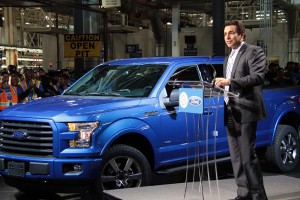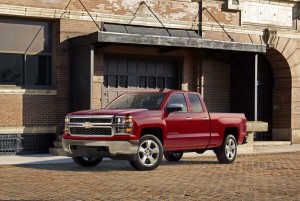
Sixty-seven percent of F-150s are rolling off the production line with V6 engines, including the 3.5-liter V6 EcoBoost.
Pickup buyers are among the industry’s most macho, and they’ve traditionally wanted the biggest, baddest engines they could stuff under the hood. But things appear to be shifting as automakers come up with creative alternatives that meet growing demand for better fuel economy.
Ford Motor Co. says that more than two out of three buyers of the new 2015 F-150 pickup truck are opting for V-6 engines, rather than V-8s. Demand is shifting at other manufacturers, though at not nearly the same pace – reflecting the fact that there are numerous different ways to deliver better mileage.
A decade ago, “I definitely would not have expected this,” said analyst David Sullivan, of AutoPacific, Inc. “Nobody would have expected V-6s to develop the way they have in terms of power for displacement, but they’re now making as much power as many of the V-8s of a decade ago.”
That’s the case with Ford’s biggest V-6 which can match the performance and towing numbers of its top-line V-8 of just a few years back.

While not selling them in the same numbers as Ford, Chevy is also seeing an increase in V6-equipped full-size pickups.
Three of the four engines offered on the 2015 Ford F-150 are now V-6s. Of those, two have adopted turbocharging to deliver a balance of fuel economy and the heft truckers need. That includes the new twin-turbo 2.7-liter EcoBoost which is rated at 19 mpg City, 26 Highway and 22 Combined while still yielding 325 horsepower.
If anything, Sullivan says he expects this package to gain even more traction with truckers going ahead.
At the bottom of the Ford F-150 line-up is the price-based 282-hp, naturally aspirated V-6. Then there’s the 3.5-liter EcoBoost V-6 getting a 17/24/20 mpg rating from the EPA. The only V-8 left in the line-up right now is the 385-hp 5.0-liter package.
With 67% of its 2015 F-150 trucks going out the door with V-6s, Ford is well ahead of its competitors, especially General Motors and Fiat Chrysler, in making that transition. It underscores Ford’s emphasis on the EcoBoost line-up, an engine family that will be available, in one of many forms, in roughly 80% of its product lines for the 2016 model-year. Even the Mustang now has an EcoBoost option, as well as a conventional V-6.
(Twist of a knob to make towing easier with new F-150. For more, Click Here.)
All told, Ford has sold 701,000 F-150s with EcoBoost engines since the first of those powertrains was added to the truck’s option list.
The competition hasn’t been ignoring either the engine downsizing trend or the demand for better mileage, it’s just that, “they’re achieving similar results, just going down different paths” to get there, said Sullivan.
Along with the addition of a third V-6 for 2015, Ford introduced a complete redesign of its full-size truck model, switching from conventional steel to an “aluminum-intensive” body shaving as much as 700 pounds of mass compared to the prior-edition truck.
(Click Here for details about why gas prices will drop just in time for summer driving.)
Lightweighting has become a major push for all manufacturers, and GM and FCA’s Ram brand are expected to use more aluminum and other mass-saving materials going forward. But they’re also introducing creative powertrain solutions.
The hot new engine for the Ram 1500 is its EcoDiesel. The 3.0-liter “oil burner” delivers massive amounts of torque while still clocking 21 mpg in the City and 29 mpg on the Highway and 24 Combined, a double-digit gain over the 2.7-liter Ford EcoBoost –though diesel fuel often carries a steep premium. To help improve mileage, Ram has also added a new eight-speed automatic to its pickup line-up.
(Editors Note: the Ram diesel figures have been revised to compare 2WD models of the Ford and Ram models.)
General Motors has adopted advanced gearboxes for its Chevrolet and GMC pickup lines, as well. And the maker has found ways to squeeze more mileage out of existing V-8s through creative engineering. That includes such technologies as displacement-on-demand, where half of the engine’s cylinders are automatically deactivated when power demands are low.
(To see more about how apps will keep drivers safer, Click Here.)
That said, most observers anticipate that demand for V-6s will continue to grow among truck buyers in the coming years. We may also see even more creative technologies, such as hybrids, gain ground as battery technology improves.

The benefit to a turbo V-6 or I-4 is increased torque across the entire operating band and lower fuel consumption when not using a lot of power. At WOT a turbo engine will consume considerably more fuel than a larger NA engine.
An NA V-6 vs. an NA V-8 is going to have a lot lower appeal to truck buyers who use their truck for hauling loads, towing, etc. as a non-turbo V-6 is typically short on torque in comparison to an equal deign V-8 engine. Torque is a necessity for hauling loads. A car maker has a lot of influence on what people buy based on the std. equipment they include and the costs of upgraded power.
Ford has some steps advanced from their competitors and trying to beat the competition by providing some features of V-6 engines,F-150,EcoBoost engine option and Lightweight structure.
Chevy is also in line to offer best solution to their customers with v8 engine.With the help of creative engineering, they are using its full capacity for better mileage.
Now lets see who wins this war 🙂
Very good responses from customers sold and just wished allocation goes up as well as production
Great Job